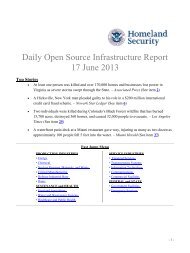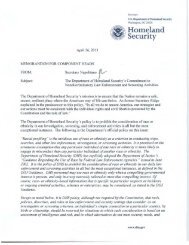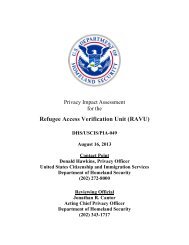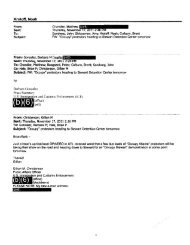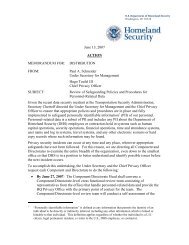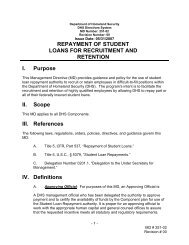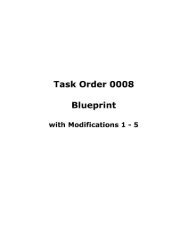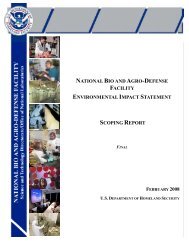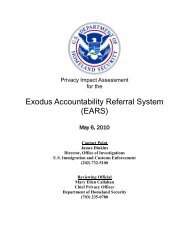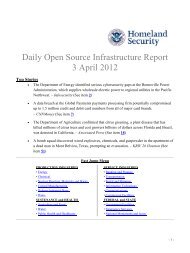Banking and Finance Sector-Specific Plan - U.S. Department of ...
Banking and Finance Sector-Specific Plan - U.S. Department of ...
Banking and Finance Sector-Specific Plan - U.S. Department of ...
Create successful ePaper yourself
Turn your PDF publications into a flip-book with our unique Google optimized e-Paper software.
linked to payments occurring in systems outside the United States. Also, the securities clearing systems such as the Depository<br />
Trust & Clearing Corporation for the equities <strong>and</strong> government securities markets <strong>and</strong> The Options Clearing Corporation for the<br />
securities derivatives markets, process more than 8.35 billion transactions worth $1.01 quadrillion annually. 22<br />
Retail customers are increasingly processing their transactions with their depository institutions via the Internet. Financial<br />
regulators have issued extensive guidance to these institutions on how to manage this activity <strong>and</strong> mitigate the risks associated.<br />
These deposit <strong>and</strong> payment system products are governed by a complex system <strong>of</strong> requirements, generally promulgated by<br />
Federal banking agencies, the SEC, or private SROs or rule-making bodies. The organizations operating payment systems are<br />
examined for compliance purposes by the appropriate agencies. For example, distinct Federal regulations govern the processing<br />
<strong>of</strong> funds stemming from checks, <strong>and</strong> inter-bank funds transfers, while ACH payments are governed by rules promulgated by<br />
NACHA-The Electronics Payment Association.<br />
2.2.2 Credit <strong>and</strong> Liquidity Products<br />
Credit markets are not formal markets with either a physical location or one narrow set <strong>of</strong> methods that define them. Rather,<br />
there are a wide variety <strong>of</strong> financial firms that provide credit <strong>and</strong> financing, including more than 17,000 depository institutions<br />
in the United States, 23 <strong>and</strong> a wide variety <strong>of</strong> non-depository providers, including mortgage financing firms, <strong>and</strong> many others.<br />
Moreover, many <strong>of</strong> the financial firms that provide financing at retail institutions require liquidity to fund their financing activity.<br />
The number <strong>of</strong> financial services providers <strong>of</strong> credit <strong>and</strong> liquidity is extremely large, due to the many specialized niche markets<br />
serviced <strong>and</strong> the <strong>of</strong>ten highly tailored financial services provided. Given the many types <strong>of</strong> products, there is no single set <strong>of</strong><br />
systems at work that dominates these financial products. However, throughout the entire financial services sector there are rigid<br />
goals <strong>of</strong> safeguarding the assets <strong>of</strong> clients <strong>and</strong> ensuring that client assets, the financial firms’ assets, <strong>and</strong> recordkeeping systems<br />
are highly resilient to any foreseeable event.<br />
2.2.3 Investment Products<br />
Collectively, the thous<strong>and</strong>s <strong>of</strong> investment service providers own more than $16 trillion24 in financial assets. Many <strong>of</strong> these<br />
providers operate in a highly regulated environment governed by a complex legal structure.<br />
Some <strong>of</strong> these investment products are provided on highly formalized financial markets, while others are provided by regulated<br />
financial services providers not acting specifically in a formal financial market. Examples <strong>of</strong> highly developed formal financial<br />
markets include financial exchanges, at which financial assets are traded in a tightly regulated manner so as to achieve the<br />
desired purposes <strong>of</strong> market participants.<br />
These formal financial markets have highly developed <strong>and</strong> extremely efficient, redundant networks <strong>and</strong> systems that provide a<br />
high degree <strong>of</strong> resilience for these markets in the face <strong>of</strong> a variety <strong>of</strong> potential situations. Additionally, these networks incorporate<br />
strong safeguards to protect clients’ assets <strong>and</strong> provide both the customers <strong>and</strong> institutions with consistent access to their<br />
funds <strong>and</strong> records.<br />
2.2.4 Risk-Transfer Products<br />
Risk-transfer products include insurance <strong>and</strong> hedging instruments such as futures <strong>and</strong> options. Hedging instruments valued at<br />
close to $1 quadrillion are traded annually. 25 Insurance covers in excess <strong>of</strong> $6 trillion26 worth <strong>of</strong> assets. Financial risk-transfer<br />
22 www.dtcc.com/AboutUs/2005annual/dtcc2005_annual.pdf <strong>and</strong> www.theocc.com/about/ann_rep/ann_rep_pdf/annual_rep_05.pdf.<br />
23 www2.fdic.gov/sod/sodSumReport.asp?barItem=3&sInfoAsOf=2006 <strong>and</strong> www.ncua.gov/data/FOIA/foia.html.<br />
24 www.federalreserve.gov/releases/Z1/Current/annuals/a1995-2005.pdf.<br />
25 www.cme.com/about/ins/caag/FacFigu2803.html <strong>and</strong> www.theocc.com/about/ann_rep/ann_rep_pdf/annual_rep_05.pdf.<br />
26 www.federalreserve.gov/releases/Z1/Current/annuals/a1995-2005.pdf.<br />
<strong>Banking</strong> <strong>and</strong> <strong>Finance</strong> <strong>Sector</strong>-<strong>Specific</strong> <strong>Plan</strong>



